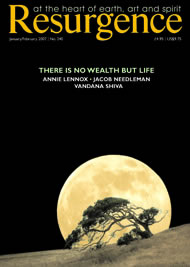TODAY’S IDEAS OF reincarnation, karma and Tibetan wisdom owe much to Helena Petrovna Blavatsky (1831–1891). Born into the Russian aristocracy, she became a runaway bride in her late teens. Long fascinated by the occult books in her great-grandfather’s library, she travelled in search of ancient wisdom and mysterious cults throughout Egypt, the Middle East and India during the 1850s and 1860s. While the modern world sped ever faster towards a future defined by rationality, science and technology, she returned to traditional sources, seeking out dervishes, yogis and other initiates of lost occult knowledge.
Her quest ultimately led her to Tibet, where she claimed to be the pupil of two exalted masters or mahatmas (great souls), who offered spiritual guidance in the form of cosmological secrets and the evolutionary potential of the human spirit. Determined to challenge the materialism and secularism of the West, she flirted with American spiritualism in the early 1870s before launching Theosophy, a new vision of the cosmos and human purpose based on the revelations of her Tibetan mahatmas.
Founded in New York in 1875, the Theosophical Society moved its operations to India in 1879, where its present-day headquarters were established at Adyar, near Madras, in 1883. The rapid expansion of the Theosophical Society in Europe and America spurred the popularity of Oriental religions and the modern occult revival. Blavatsky became a legend in her own time.
As a prolific writer of magazine articles and the author of key esoteric texts, Blavatsky offered widespread access to esoteric ideas. Her monumental works, Isis Unveiled and The Secret Doctrine, were important fronts in the modern revaluation of the occult tradition for educated audiences in the late 19th century. Her movement generated a sufficiently large following in America and Europe to support busy magazine and book publishing projects on esoteric subjects.
Despite its alleged Eastern provenance, Theosophy in its early stages drew major sustenance from Western occult sources, including Gnosticism, Neoplatonism, Pythagoreanism, alchemy, astrology and magic, Rosicrucianism, secret societies and Freemasonry. In this respect, Theosophy repeated the Western embrace of the East in the early centuries CE, when the Hellenistic world-empire bequeathed by Alexander the Great combined Greek philosophy with the religious traditions of Chaldæa, Babylonia and Assyria. In the era of European colonialism, Theosophy combined the Western esoteric tradition, including Hermeticism, Kabbalah and numerous borrowings from ancient Egyptian and Graeco-Roman religion, with Eastern doctrines taken from Buddhism, Hinduism and Oriental mythology. Just as the late Roman Empire saw the rise of numerous sects in the Mediterranean area and the Middle East, so the rapid growth of Theosophy perfectly illustrated the appeal of religious syncretism in modern Europe and America.
The Emerald Tablet of Hermes Trismegistus, the legendary Egyptian sage, contains the famous motto “As above, so below”, thereby indicating that the pattern of Earthly life follows that of the heavens. The world of the microcosm (the human being) is linked through innate correspondences with the world of the macrocosm (the universe). Layers of creation, levels of consciousness, and cosmic planes are all interconnected in a meaningful, animate world-soul. Likewise, Blavatsky asserted the fundamental identity of all souls with the universal over-soul and the obligatory pilgrimage for every soul to pass through the cycles of incarnation in order to seek reunion with the absolute. This cyclical vision of itinerant salvation was also rooted in the periodicity of nature, evident in the stars, the planets and the seasons. It incorporated the modern Western idea of evolution, absent in Oriental religion and philosophy, whereby each soul had a duty to progress up the spiral of spiritual development to ever higher levels of being.
By 1900, as a direct result of Theosophy, the esoteric tradition entered public consciousness and Western culture on a scale not seen since the efflorescence of astrology, alchemy and magic in the 16th century. Blavatsky’s works and the Theosophical Society acted as a prism refracting the esoteric heritage of antiquity, post-Renaissance Europe, and Asia to younger and wider audiences. Her promotion of an ancient and universal wisdom-tradition, her claims to initiation by exalted masters in Tibet, and her pleas for a universal brotherhood irrespective of race, religion, and sex caught the progressive imagination.
Blavatsky died in London in 1891 but her influence on posterity was substantial in both India and the West. The later history of the Theosophical Society under the leadership of Annie Besant and her presidency of the Indian National Congress underline the Society’s role in the growth of Indian national consciousness; both Gandhi and Nehru acknowledged Theosophy as a factor in the rediscovery of their own religious and philosophical heritage. Leading figures of the Irish literary renaissance, including W. B. Yeats, George Russell (Æ) and Charles Johnson were drawn to Theosophy. G. R. S. Mead, Blavatsky’s private secretary in his youth, became the leading translator of Gnostic and Hermetic texts, inspiring Carl Gustav Jung’s lifelong interest in Gnosticism and alchemy. Nowadays ideas of spiritual growth, guiding masters, reincarnation and the soul’s journey are commonplaces of New Age religion. Blavatsky has become a powerful and implicit influence on 20th-century esoteric movements, confirming her status as the foremother of alternative spirituality in our own time.
The book Helena Blavatsky is published as part of the Western Esoteric Masters Series by North Atlantic Books, 2004.







